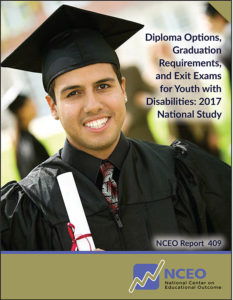 NCEO’s report, Diploma Options, Graduation Requirements, and Exit Exams for Youth with Disabilities: 2017 National Study, examines the results of a national study on the status of state graduation policies and diploma options for youth with disabilities. State policies and perceptions of intended benefits and possible unintended consequences are summarized and compared to the findings of a previous study by Johnson, Thurlow, and Schuelka (2012). The rationale for these studies is based on three assumptions. First, state and local district graduation requirements for students with and without disabilities continue to evolve, and there is a need to follow these policy trends and examine their impact on youth with disabilities. Second, states and local districts are also providing a range of differentiated diploma options for students with and without disabilities, and these options need to be examined to assess their potential impact on youth with disabilities. Third, as states and local districts proceed in implementing these policies and procedures, additional information is needed to examine both their intended and unintended consequences for youth with disabilities.
NCEO’s report, Diploma Options, Graduation Requirements, and Exit Exams for Youth with Disabilities: 2017 National Study, examines the results of a national study on the status of state graduation policies and diploma options for youth with disabilities. State policies and perceptions of intended benefits and possible unintended consequences are summarized and compared to the findings of a previous study by Johnson, Thurlow, and Schuelka (2012). The rationale for these studies is based on three assumptions. First, state and local district graduation requirements for students with and without disabilities continue to evolve, and there is a need to follow these policy trends and examine their impact on youth with disabilities. Second, states and local districts are also providing a range of differentiated diploma options for students with and without disabilities, and these options need to be examined to assess their potential impact on youth with disabilities. Third, as states and local districts proceed in implementing these policies and procedures, additional information is needed to examine both their intended and unintended consequences for youth with disabilities.
Responses were collected from states via an online survey that contained questions aligned to previous surveys. Respondents were state directors of special education or their designees in all 50 states, the District of Columbia, and two territories, the Virgin Islands and Micronesia. Results indicated some changes in graduation requirements and diploma options from the previous survey. Trends found include:
- There is a strong increasing trend in states to providing diploma options exclusively for youth with disabilities.
- There has been a break in trend in states increasing graduation requirements.
- The exit exam requirement is becoming less common.
Recommendations from this study are:
- Clarify the assumptions underlying state graduation requirements and diploma options.
- Ensure students with disabilities have the opportunity to learn the material they will be tested on in state and local assessments.
- Make high school graduation decisions based on multiple indicators of students’ learning and skills.
- Clarify the implications of developing and granting different diplomas for students with disabilities.
- Conduct ongoing research on the intended and unintended consequences of state graduation requirements and diploma options.
